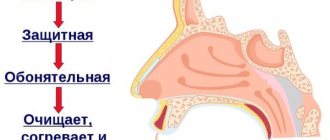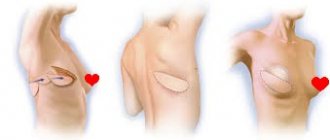When can colpoperineorrhaphy with levatoroplasty be performed?
The operation is prescribed if the doctor diagnoses:
- prolapse or drooping of the vaginal walls;
- rupture of the perineum with protrusion of the rectum;
- rectocele.
Colpoperineorrhaphy with levatoroplasty is a plastic surgery for the purpose of suturing the posterior vaginal wall and perineum, which is performed when the posterior vaginal wall prolapses with simultaneous protrusion of the walls of the rectum.
Colpoperineorrhaphy is prohibited if the patient has the following diseases:
- respiratory or heart failure;
- infectious diseases;
- acute inflammatory processes of the pelvic organs;
- diabetes;
- blood clotting pathologies;
- malignant tumors or metastases in the area of surgery;
- kidney diseases.
Types of colporrhaphy and technique
Colporrhaphy is a gynecological intervention that is performed through the vagina in order to strengthen and restore the vaginal walls in diseases associated with weakening and damage to the pelvic floor wall, in particular, prolapse of the uterus, rectum and bladder. For this type of surgery, both the patient’s own tissue and implants made of synthetic materials can be used.
Pelvic organ prolapse occurs depending on which organs prolapse through the vaginal wall: the uterus, rectum, or bladder. Most often, there is pain in the lower abdomen of a pulling and aching nature, which radiates to the tailbone and sacrum area. There may also be a sensation of a foreign body in the vagina. Some patients experience symptoms of dyspareunia - pain during sexual intercourse. In cases where the prolapse is associated with the bladder, frequent urination and urinary incontinence are observed; in case of rectal prolapse, constipation, incontinence of feces and gases, and prolapse of hemorrhoids are observed.
Treatment of such conditions can be either conservative or surgical. Conservative measures are based on physical therapy and special exercises. If they are ineffective or when prolapse of the pelvic organs manifests itself with intense symptoms, they resort to methods of surgical correction, in particular, colporrhaphy.
The essence of the colporrhaphy operation is to excise excess, sagging and stretched tissue of the vaginal wall, followed by suturing it in the form of a duplicate or applying a synthetic implant in the form of a mesh, as in the case of hernias.
Colporrhaphy can be of several types, depending on which vaginal wall is undergoing plastic surgery: anterior and posterior. Another type of colporrhaphy is with a synthetic implant (“mesh”).
Among the indications for anterior colporrhaphy is prolapse of the anterior vaginal wall, especially when there is prolapse of the pelvic organs - rectum or bladder, with slight prolapse of the uterus or even its absence. It is not recommended to carry out this intervention if you are planning pregnancy and childbirth in the near future, since during pregnancy and childbirth a recurrence of damage to the anterior vaginal wall may occur. Most often, surgery is indicated for pre- or postmenopausal women.
Indications for posterior colporrhaphy include rectocele - prolapse of the intestine into the vaginal lumen, subject to slight prolapse of the uterus or even its absence. In this case, the involvement of the perineal wall in the pathological process is also noted. Posterior colporrhaphy is usually combined with plastic surgery of the anterior vaginal wall.
Colporrhaphy surgery is performed under general anesthesia - endotracheal anesthesia, intravenous anesthesia, or under conduction anesthesia in the form of epidural or spinal anesthesia.
Anterior colporrhaphy, the so-called colpoperineolevatoroplasty, includes plastic surgery of the pelvic floor muscles, the vaginal wall and the vaginal opening. First, the doctor excises excess tissue of the vaginal wall, after which plastic surgery and tightening of the pelvic floor muscles (levators) are performed, and at the last stage, narrowing of the entrance to the vagina. This intervention is widely used in patients with an overstretched vagina and an enlarged vaginal opening.
Posterior colporrhaphy includes the same steps - plastic surgery of the posterior vaginal wall with excision of excess tissue and creation of a duplication, tightening of the pelvic floor and vaginal muscles, as well as narrowing of the vaginal opening. In addition, as noted above, posterior vaginal repair is almost always combined with anterior colporrhaphy. Most often, anterior colporrhaphy in addition to posterior colporrhaphy is performed for cosmetic reasons.
Another type of colporrhaphy is the so-called. median colporrhaphy. This intervention is usually performed in elderly patients who are not sexually active, with a stretched perineal wall. With median colporrhaphy, the surgeon excises trapezoid-shaped areas along the anterior and posterior wall of the vagina. Next, plastic surgery of the pelvic floor levator muscles is performed. At the last stage, the doctor places the prolapsed genitals back into the pelvic cavity, after which the wound is sutured in such a way that the entrance to the vagina becomes almost closed
Colporrhaphy and plastic surgery of the pelvic floor muscles are always performed in case of surgery to remove the uterus through the vagina (so-called vaginal hysterectomy), if the patient has prolapse of the pelvic organs.
The use of synthetic implants in the form of a mesh for plastic surgery of the vaginal wall is usually indicated in women at least 45 years of age; in other cases, such a need is determined only by a doctor. The most common synthetic material is polypropylene. Polypropylene mesh for colporrhaphy is usually used in cases where plastic surgery of the pelvic floor and vaginal walls is impossible with one’s own tissues due to their severe weakness. In such cases, the defect in the vaginal wall is closed with a mesh. The mesh also strengthens the pelvic floor in cases of severe weakness and thinning of the levator muscles.
Modern gynecological clinics and leading medical centers in the USA, Israel, Germany and Japan today use the latest colporrhaphy techniques, incl. using laparoscopic and robotic technology, which minimizes the risk of complications during and after surgery, shortens the postoperative period, and also reduces the frequency of relapses. Highly effective and safe methods that meet international standards, the highest qualifications of operating gynecologists, comfortable conditions in clinics, service and friendliness of the staff, as well as an individual approach to each patient - all this attracts many Russian patients with pathology of the vaginal walls to well-known medical centers in foreign countries.
Possible complications of colpoperineorrhaphy with levatoroplasty
Colpoperineorrhaphy can cause various complications:
- allergic reactions to anesthesia in the absence of informing the doctor by the patient;
- damage to the rectum due to the carelessness of the surgeon;
- bleeding if restoration measures are not followed;
- an increase in temperature several days after surgery indicates the development of an abscess caused by hemorrhage in the muscles.
Video: Prolapse of the vaginal walls. Is it dangerous?
Attention!
This article is posted for informational purposes only and under no circumstances constitutes scientific material or medical advice and should not serve as a substitute for an in-person consultation with a professional physician.
For diagnostics, diagnosis and treatment, contact qualified doctors! Number of reads: 5431 Date of publication: 10/26/2017
Gynecologists - search service and appointment with gynecologists in Moscow
Indications for levatoroplasty
- The appearance of a cystocele against the background of prolapse of the anterior vaginal wall;
- Partial prolapse of the uterus and prolapse of the vaginal walls with the appearance of rectocele;
- Loss of pelvic floor muscle tone and vaginal prolapse in women under 60 years of age;
- Complete vaginal eversion with the need for hysterectomy in women over 60;
- Stretching of the perineal muscles in combination with complete prolapse of the uterus and vagina in elderly women;
- Prolapse of the pelvic organs in combination with gynecological pathologies (cervical dysplasia, large uterine fibroids, ovarian tumor, etc.).
Each woman is individual, as is the anatomical structure of her genital organs, therefore, in each specific case, the surgeon personally determines the scope of surgical intervention. Most often, any type of colporrhaphy is performed with surgery on the pelvic floor muscles (levatoroplasty).
To perform levatoroplasty, certain indications must be present: weakness, laxity, or levator rupture. This is determined by examination by palpation. Often the levators are torn after an episiotomy. Subsequently, the woman has the sensation that the vagina is wide open. Where the muscle used to be stretched is now empty. The vagina seems to be pulled to the side, towards the side of the episiotomy.
Young women often complain that water flows into the vagina when visiting the pool, and unpleasant sounds occur during sports. The reason for this is the deformation of the perineum. To eliminate these signs, surgery is indicated on the circular muscles, which are located on the surface. In this case, perineal plastic surgery (perineoplasty) is performed.
Anterior and posterior levatoroplasty with colporrhaphy
Suturing the pelvic floor muscles with simultaneous elimination of prolapse of the vaginal walls and perineal plastic surgery (colpoperineolevatoplasty) can reduce the size of the vagina, eliminate prolapse or prolapse of the pelvic organs, achieve an aesthetically attractive result and significantly improve the quality of sexual life.
Colpoperineorrhaphy with levatoroplasty – rehabilitation
After such a major surgical intervention, you must carefully follow all the instructions of your surgeon regarding the rules of the rehabilitation period. The duration of rehabilitation is 2 months. After this, it is allowed to gradually return to sports, and restrictions on sexual contact are lifted. With proper preparation and following recommendations in the postoperative period, the risk of complications is minimal.
Colporrhaphy with levatoroplasty - complications
The main problems that may arise after any type of pelvic floor shaping surgery include:
- bleeding from the wound;
- injury to nearby neighboring organs;
- severe pain in the coming weeks after surgery;
- various urinary disorders;
- suppuration of a postoperative wound;
- recurrence of genital prolapse.
Levatoplasty: postoperative period
Levatoplasty in combination with colporrhaphy and perineal plastic surgery is performed for the following indications. Restrictions on the rehabilitation period after levatoroplasty include:
- Avoid sitting for 2 weeks;
- The first days after pelvic floor muscle plastic surgery, it is recommended to adhere to a diet that involves eating semi-liquid food. This is necessary to avoid constipation.
- After levatoroplasty, you need to refrain from sports and heavy physical activity for 2 months.
- If you are planning a pregnancy in the near future, then at least a year and a half should pass after levator plastic surgery.
Possible complications
By choosing a competent and experienced plastic surgeon, you automatically reduce the risks of complications after levatoroplasty to a minimum. Our clinic is operated by gynecological surgeons with more than 20 years of experience, specializing in colporrhaphy and levatoroplasty, and having impressive medical experience.
Colpoperineolevatoplasty is a serious surgical intervention that requires the doctor to have extensive knowledge and experience in the field of operative gynecology and plastic surgery. Our specialists will return you women's health and the joy of intimate life.











